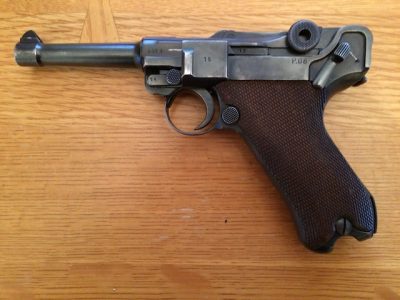Perhaps the most recognizable and iconic pistol of all time is the Pistole Parabellum, or German P 08, commonly referred to as the Luger. Originally developed by Austrian gun designer George Luger in 1898, it was adopted by the German Military in 1908, hence the nomenclature “P” for Pistole and “08” for the year.
A true testimony to German engineering, the Luger was as well-built a weapon as was ever mass produced for military service. Immediately recognizable due to its unique toggle design, the Luger’s balance, semiautomatic functionality, eight- round magazine capacity and association with the German military proved immensely popular, and it became one of the most sought-after “war souvenirs” in two world wars.
Most, but not all, were manufactured in Germany by DWM (Deutsche Waffen und Munitionsfabriken) and Mauser. While most had a standard barrel length of 4 inches, there were also 6-inch (Naval) and 8-inch (Artillery) versions. Most were 9 MM in caliber, but others were in .30 caliber.
Having attracted worldwide attention, the Luger even attracted the interest of the U.S. military. Before settling on the Colt 1911 .45 pistol as the standard U.S. military sidearm, the U.S. Army ordered several Lugers for the purposes of testing and evaluation. Prior to WW l, there was even a model known as the “American Eagle,” designed for sale in the U.S. market.
Used extensively by the German military in WW I, it was also produced for various foreign governments. This resulted in a multitude of variations, as well as an assortment of accessories, including a detachable shoulder stock and a “snail drum magazine” which could increase round capacity from the standard 8 to 32. Production continued between the wars and commercial models were widely sold on the civilian market. The many variations made it a collector’s dream, and to this day, the Luger remains one of the most sought-after and collectible pistols.
As Germany geared up for the Second World War, the demand for sidearms skyrocketed and so did production of the Luger. Due to buyouts and name changes, after World War l, production was taken over primarily by Mauser. In an attempt to hide the actual number of weapons being produced and who was producing them, and to circumvent the terms of the Treaty of Versailles (which limited the size of the German military and military arms production), Germany used a system of letter and numeric codes rather than having the name of the manufacturer appear on the pistol. This also served as a security measure once the war started. If a shipment of newly manufactured Lugers was captured, enemy intelligence would not be able to determine when and where they had been made. Therefore, they would not be able to seek out and destroy the facility producing the pistols.
Beginning in the 1930s, Mauser began using code “S/42” and later switched to “BYF,” although the Mauser “banner” still appeared on commercial pieces and pieces destined for use by Germany’s police agencies.
As the Second World War dragged on, the Luger fell victim to its own lofty production standards. The Luger was made from top quality materials, comprised of individually machined parts, serial numbered and matching to each individual piece. In short, production was expensive, extremely labor intensive and far too time consuming.
After 1942, production at the Mauser and other arms factories switched over to the Walther designed P 38. A semiautomatic pistol in 9MM, it had fewer moving parts and was easier, cheaper and less time consuming to manufacture. It soon replaced the Luger as Germany’s standard 9MM sidearm.
The Luger pictured here was brought back from WWII, as a souvenir, by U.S. Army T/5 John Maoloni, who served with a recon unit in Africa and Europe. We are honored to have this highly desirable pistol donated to our museum and on permanent display.
This is a typical Mauser military-issue piece as indicated by the letter code “BYF.” It was manufactured in 1942, near the end of the WWII production run. It is 100 percent matching numbered and carries Waffenamt military acceptance proof marks. It retains its dark lustrous bluing, beautifully checkered wood grips and high-quality finish. This is a firearm work of art that has stood the test of time.



0 comments on “Targeting an iconic sidearm”